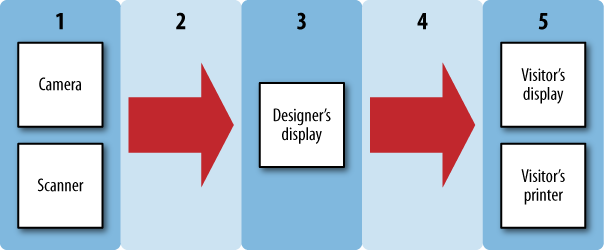Working with Color Profiles
As was pointed out in Chapter 9, what you see when creating or implementing a site design is not necessarily what your visitors will see. Hardware quality is the most significant contributor to such deviations, but the assumptions under which hardware is configured also play a role.
Every medium commonly used to display web documentsâe.g., liquid crystal diode (LCD) screens, cathode ray tube (CRT, TV-type) screens, projectors, sheets of multipurpose paper, coated paperâhas different physical characteristics that define how it displays color. These media are all manufactured under certain assumptions about the gamut of colors they will display, and the level of ambient light available to the viewer. All of these factors (and others) affect the colors seen by the consumer of your content, so graphics files often contain color profiles that define the color reproduction characteristics of the tools used to create them. Figure 11-5 describes the relationship between device and media color profiles.

Figure 11-5. Five stages of color management: creation, upload, alteration, transmission, and consumption
In the mid-1990s, Microsoft and Hewlett-Packard approached the challenge of differing display media by publishing the sRGB color space, a physical description of color that can be used in the design and calibration of electronic display hardware. The sRGB ...
Get HTML & CSS: The Good Parts now with the O’Reilly learning platform.
O’Reilly members experience books, live events, courses curated by job role, and more from O’Reilly and nearly 200 top publishers.

